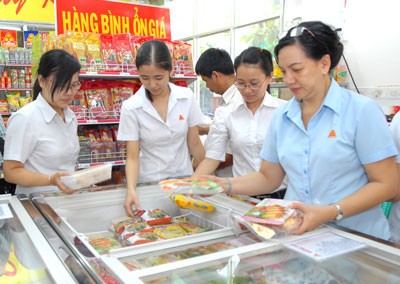(VOVworld) - The Prime Minister’s directive on market stabilization requires all ministers, sectors and localities to strictly control the prices of essential goods and services. The move aims to ensure a balance of supply and demand in the run up to the forthcoming Lunar New Year. This will help to boost output and trade, stimulate consumer purchasing power, and clear up inventory. It targets developing the domestic market to help the campaign that calls on Vietnamese people to prioritize goods that are made-in-Vietnam. VOV’s To Tuan reports….
 |
| Purchasing food at stabilization prices at Vissan company in Tan Phu District, HCMC.( Photo: Cao Thang ) |
During the last few months of this year, the prices of many essential goods tend to rise and along with difficulties in the national economy, including a slow growth rate of exports, and a decline in imports and domestic purchasing power, and large stockpiles of goods has led to worries of a sharp rise in CPI. In September, the consumer price index rose by 2.2% over August, the highest this year. To control inflation and maintain marcro-economic stability, the Prime Minister has issued a directive to step up the management and control of prices at the year’s end. A network of more than 6,400 outlets selling state-subsidized commodities have been set up nationwide. It has been expanded to cover rural and remote areas, industrial parks, and processing zones. Deputy Minister of Trade and Industry Ho Kim Thoa said that the cost of the selected items must be 5 to 10% lower than current market prices and of the same type and quality. Ms Thoa says ‘More and more outlets to sell goods at stabilized prices have been set up throughout the country. In the past, every business taking part in the program had had to arrange capital to stockpile goods, but now over 60% of them can store their commodities by negotiating a deal with their partners.’
The Prime Minister asked every minister, sector and locality to keep a firm grip of prices and the cost of goods and essential services. These include healthcare, education services, water supplies, milk, medicines, pesticides, seeds, and fertilizers. In Ho Chi Minh City, more than 3,500 outlets have been set up and 500 mobile shops have already earned nearly 530,000 USD in revenue. In September, the city held more than 100 of the mobile sales involving 25 enterprises.
In Hanoi, over 600 have been built more than one third of them in outlying areas, tripling that of 2010. Ten products to receive subsidies include food, paper and schoolbooks. Nguyen Boi Ngoc, Director of the Lan Chi supermarket chain, says ‘We have chosen rural areas to develop our sustainable supermarket network to respond to the movement calling on Vietnamese people to buy Vietnamese goods and transport more goods to rural areas. The move has underlined the city’s policy of transporting commodities to the consumers.’
Last month, Hanoi’s CPI rose slightly by 0.37% Ho Chi Minh City recorded a rise of 4% and the country average in September was up by 1%. The government had originally targeted restricting inflation to 8%.
To Tuan